Prologue to Quantum Analysis of Real Estate Investment

The prologue shows the difference between classical analysis and quantum analysis of real estate investment (REI).
Difficulty: medium. 11 min read.
Table of Contents
Definition
Classical (traditional) and quantum analyses of investment properties use the same KPI (key performance indicator) - ROI, NOI, ,... These analyses differ only in the way the indicators are presented. Each KPI indicator is represented:
- By one value in the classic analysis
- By all possible values, which are presented in the quantum analysis plot.
The quantum plot shows which values of the indicator have a high chance of appearing in the future, and which have a lower chance of appearing in the future. A typical plot, for example, annualized ROI (Return on investment) looks like this:
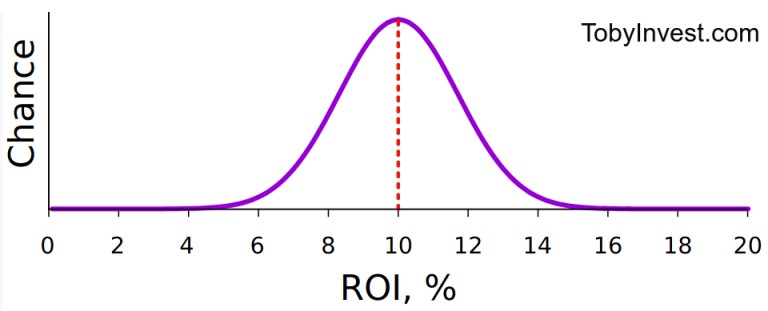
Notes to the plot:
- There is no markup on the vertical chance axis, because the absolute values of the chances do not matter. For Quantum Analysis it is enough to see the difference in chances at different values of the indicator.
- Quantum analysis includes classical analysis. The red dash marks the median. It corresponds to the ROI value of the indicator in the classical analysis.
In practice quantum plots can take even more characteristic forms. A variety of quantum plots allow to diagnose each indicator in depth.
Demo
Let's explore a few variations on how Quantum Analysis presents an annualized Return on Investment (ROI) indicator. The greater this indicator, the better the property is for investment.
"How To Calculate The ROI On A Property Investment" on Forbes.com:
A good ROI for a rental property is usually above 10%, but 5% to 10% is also an acceptable range.
Suppose an investor is willing to buy a property with an ROI of at least 10%. Our demo data set contains 7 properties from different locations in the investor's city. The classical analysis indicates an annualized ROI of 10% for each property.
Click to expand each example:
“Unfriendly spread out”
Quantum Analysis representation:
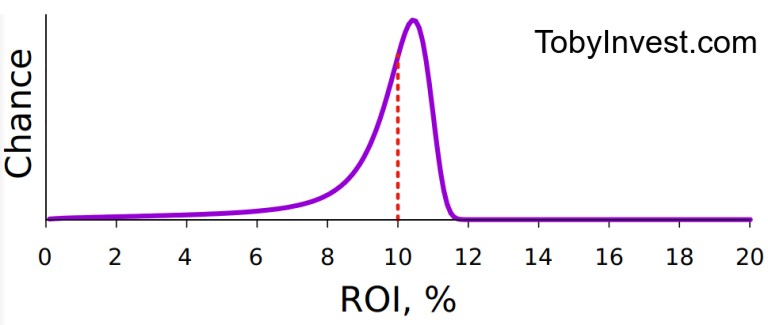
(As a reminder, the red line indicates the median, which corresponds to the value of the classic ROI.)
Quantum Explanation: Half of the time the ROI will be less than 10% and will be much lower. In the other half of the cases the ROI will be only slightly higher than 10%, so you shouldn't expect a big gain.
Quantum Advice: This property is not recommended to the investor. The chances of losing and winning are the same. But the loss is big and the gain is small.
“Friendly spread out”
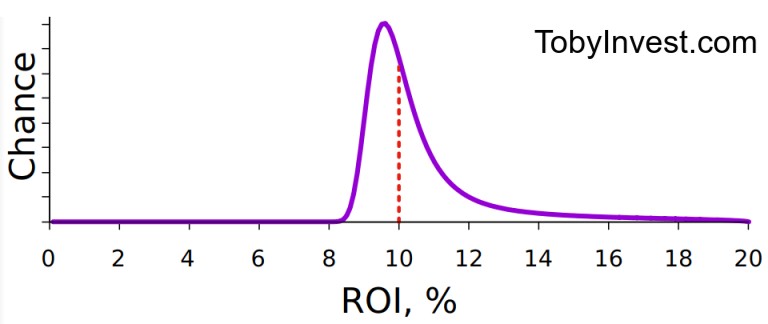
Quantum Explanation: Half of the time the ROI is much more than 10%. In the other half of the cases, ROI is less than 10%, but by a non-critical 1-2%.
Quantum Advice: “Friendly spread out” is a great option even for a beginner investor. The chances of losing and winning are the same. But winning can be very big. A loss, even if it happens, will be small.
“Roulette”
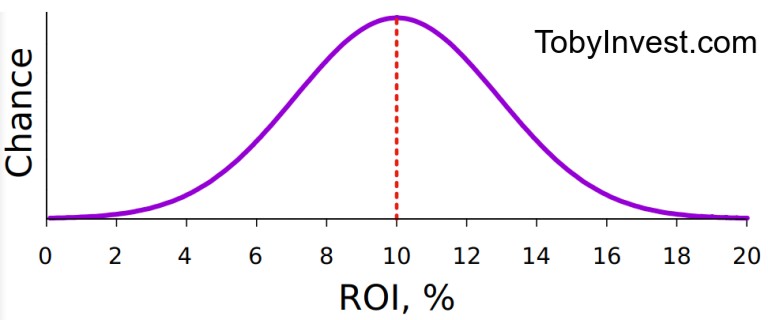
Quantum Explanation: “Roulette”. Half the time you can win big, the other half you can lose big.
Quantum Advice: This property is not recommended for first-time investors who want a reliable, good return on their first investment. Experienced investors with a lot of doors can risk taking this kind of property if other KPI indicators are good.
“Stability”
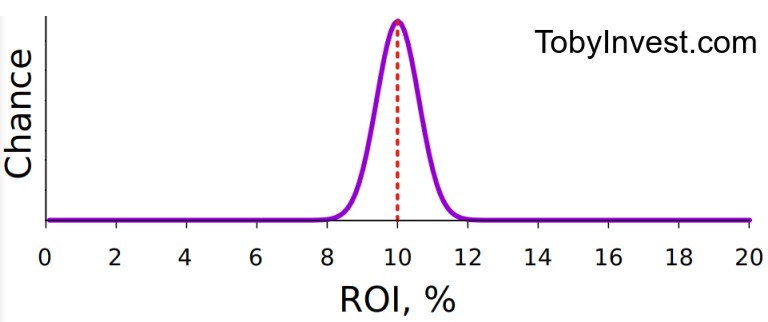
Quantum Explanation: “Stability”. This form of the plot happens when real estate in the neighborhood has a typical construction:

Quantum Advice: The stability of ROI means that if it will be different from 10%, then only a little.
“Candle”:
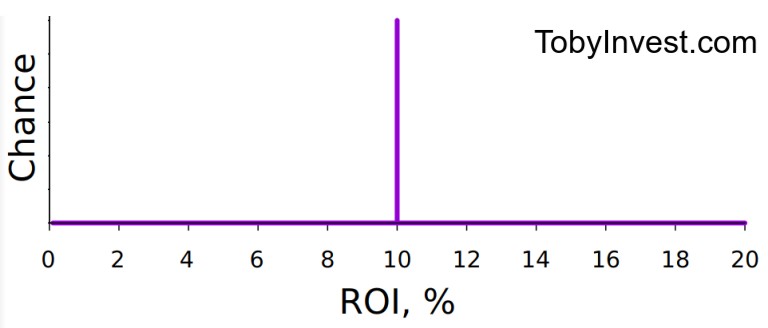
Quantum Explanation: “Candle”. The vertical line means only one possible value of ROI. This is what the indicator looks like, which the analyst calculated in the classic style of analysis.
Quantum Advice: Ask your analyst to recalculate the ROI using Quantum Analysis. It's important for you to see the shape of the ROI bell to see the chances of all the values and compare them to each other.
“Break”
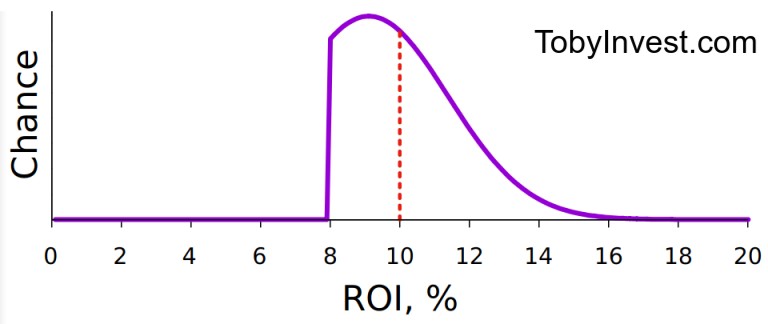
Quantum Explanation: “Break”. Possible ROI values in Quantum Analysis usually have a smooth line that descends to zero left and right. A break in the quantum plot on one or both sides at once is a sign of a failure of the quantum analysis program.
Quantum Advice: Return the analysis to the analyst and ask him to rebuild it. Most likely, he has recently fine-tuned the calculation program and now it isn't working correctly.
“Bimodality”
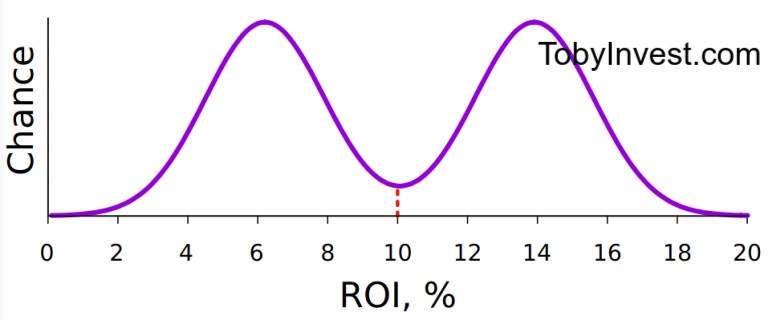
Quantum Explanation: Two bells usually indicate bimodality (double-peak) of the raw data. For example, the analysis was done on the property, which is near the ocean:

First-line homes look out over the ocean. Second-line homes look at first-line homes. The values and rents of first- and second-line homes will be radically different. Quantum analysis reflects this in the form of 2 bells on the ROI plot.
Quantum Advice: You need to clarify which modality (“peak”) the property belongs to. Ask the analyst to repeat the analysis, but only consider homes on the same line as the property being analyzed. Then there is only one “bell” on the ROI chart to which the property will belong.
In all 7 cases, the classical analysis indicates the same 10% annualized ROI, while Quantum Analysis details 7 different situations and gives 7 different tips.
There are many more than 7 characteristic forms of quantum plots. Quantum plots make dozens of diagnoses for each KPI indicator.
Niels Bohr, a founding father of Quantum Theory, received a Nobel Prize in Physics for his work on quanta. He said in June 1952:
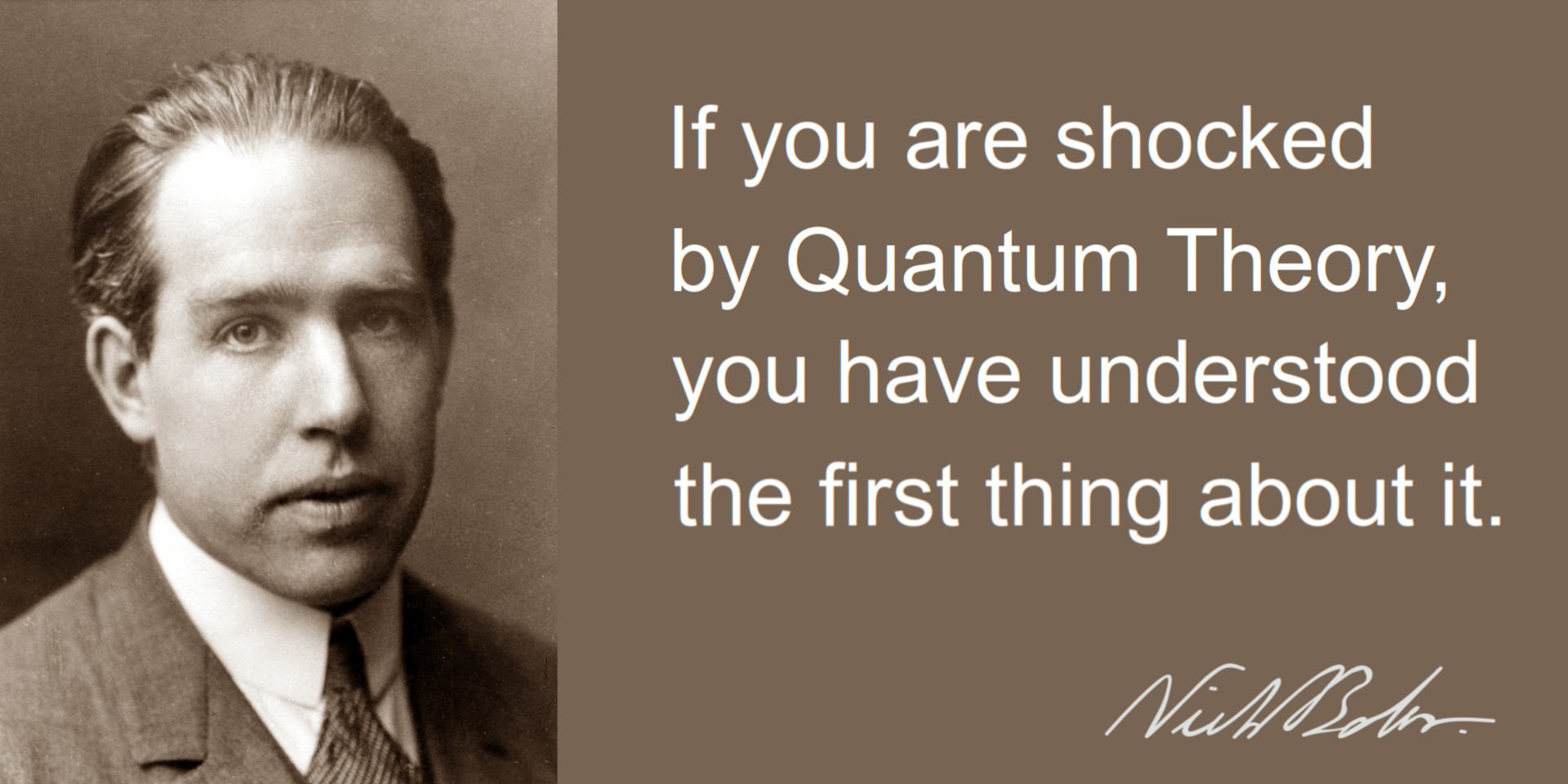
Pros
All the enthusiasm for Quantum Analysis comes from investors who use it. To name three major excitements.
Pro #1. Correspondence principle
Correspondence principle: A new theory should reproduce under some conditions the results of older well-established theories in those domains where the old theories work.
Quantum analysis of REI carefully preserves all the KPIs of classical analysis. Investors continue to use in Quantum Analysis all the experience they have gained from using classical analyses.
The explanation of ROI quantum plots took 5 minutes. Explanation of the quantum plots is the same for different KPI indicators.
If investors can easily read the results of the REI classical analysis, they can read results of the REI Quantum Analysis with even greater ease.
Pro #2. Information Value
Characteristic forms of quantum plots distinguish dozens of diagnoses about each indicator. The information value of Quantum Analysis allows:
- Finding great real estate where classical analysis doubts the suitability of real estate
- Rejecting bad real estate, which classical analysis recognizes as suitable
- Detecting of incorrectly made analyses.
Pro #3. Evidence-based
Investors don't trust classical analyses of other investors. Experienced investors are advised to ignore the classic analysis from sellers:
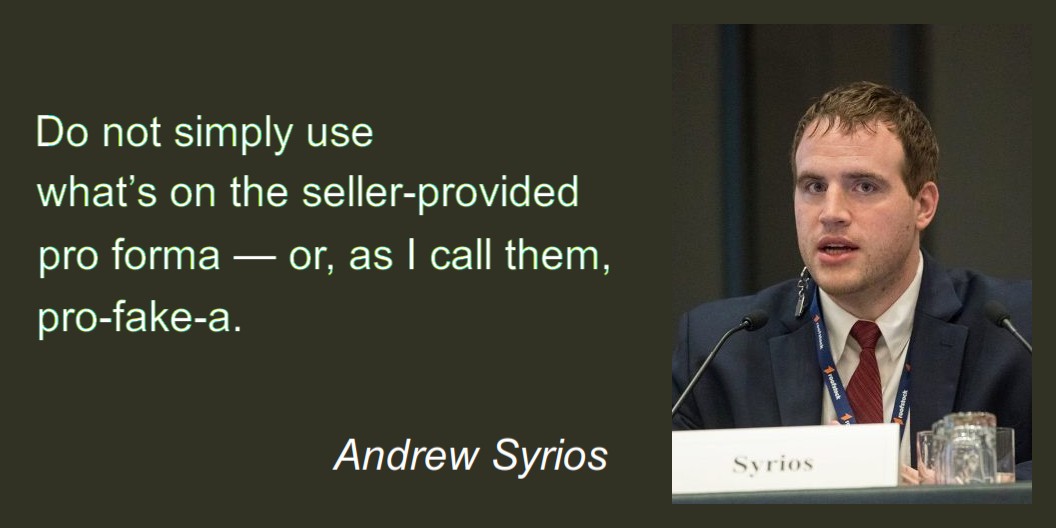
But quantum analysis plots include every conceivable and inconceivable optimistic and conservative option,... and even indicates their chances relative to each other. That's why Quantum Analysis is accepted by all real estate investors. Each of them finds a suitable value on quantum plots, according to their degree of conservatism of the buyer or optimism of the seller:
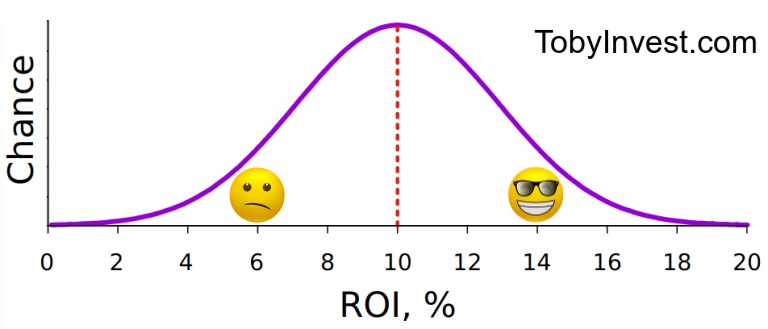
Evidence-based Quantum Analysis makes it the gold standard among real estate investors.
If Quantum Analysis follows an investment property, the buyer will no longer ask his analyst to do a classical analysis. The buyer can:
- Decide in 2-3 minutes if he has an interest in buying
- Detect incorrect analysis
- Even quietly delegate the decision to his acquisition management.
Evidence-based Quantum Analysis is especially valuable in situations where money is made fast - wholesale, filtering lists (heirs, real estate with fresh encumbrances,...)
Also evidence-based Quantum Analysis allows the use of Machine Learning (ML). Then the program will be able to independently cut off 95-97% of real estate in which the KPI does not fit this buyer.
Cons
To the extent that Quantum Analysis is easy and intuitive to use, it's just as difficult to prepare:
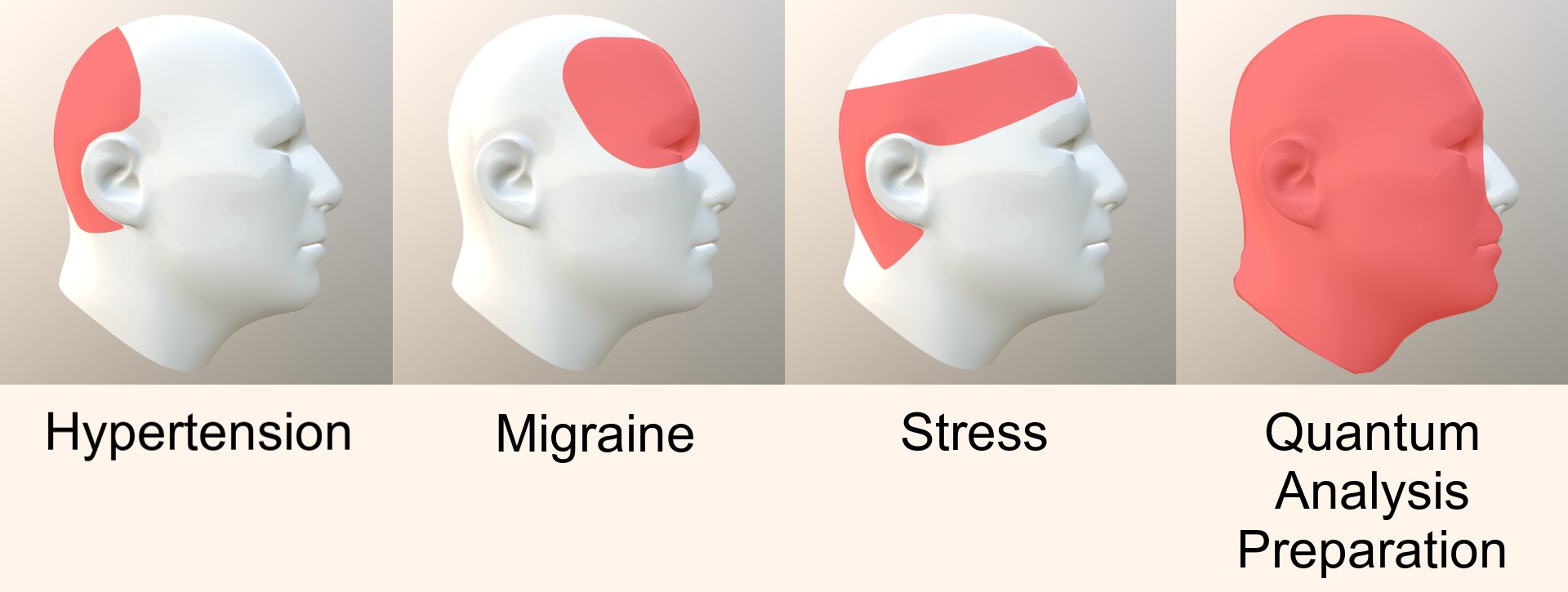
Quantum analysis is at the crossing point of Maths, programming and computers. These disciplines are the main difficulty in preparing REI Quantum Analysis.
Con #1. Maths
Formulas of REI classical analysis are very simple. Each formula consists of 2-3 variables that are related by the actions of arithmetic - add, subtract, multiply, and divide. Elementary school knowledge is enough to develop a classical analysis of real estate investment.
Experienced investors adore to explain classic analysis of REI on a napkin for beginners:
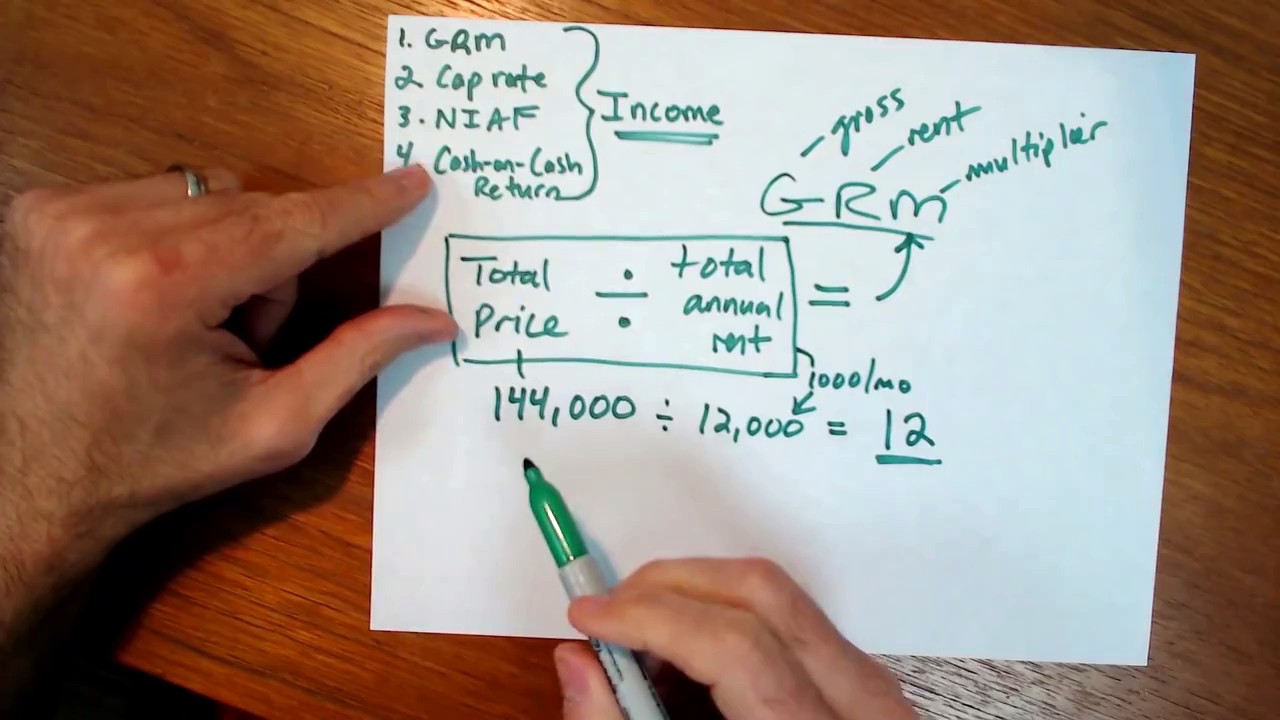
The Math of Quantum Analysis is studied during the final years of Math and Physics faculties. The formulas are complicated and there are many of them. The end of the lecture on the uncertainty principle of Quantum Mechanics looks like this:
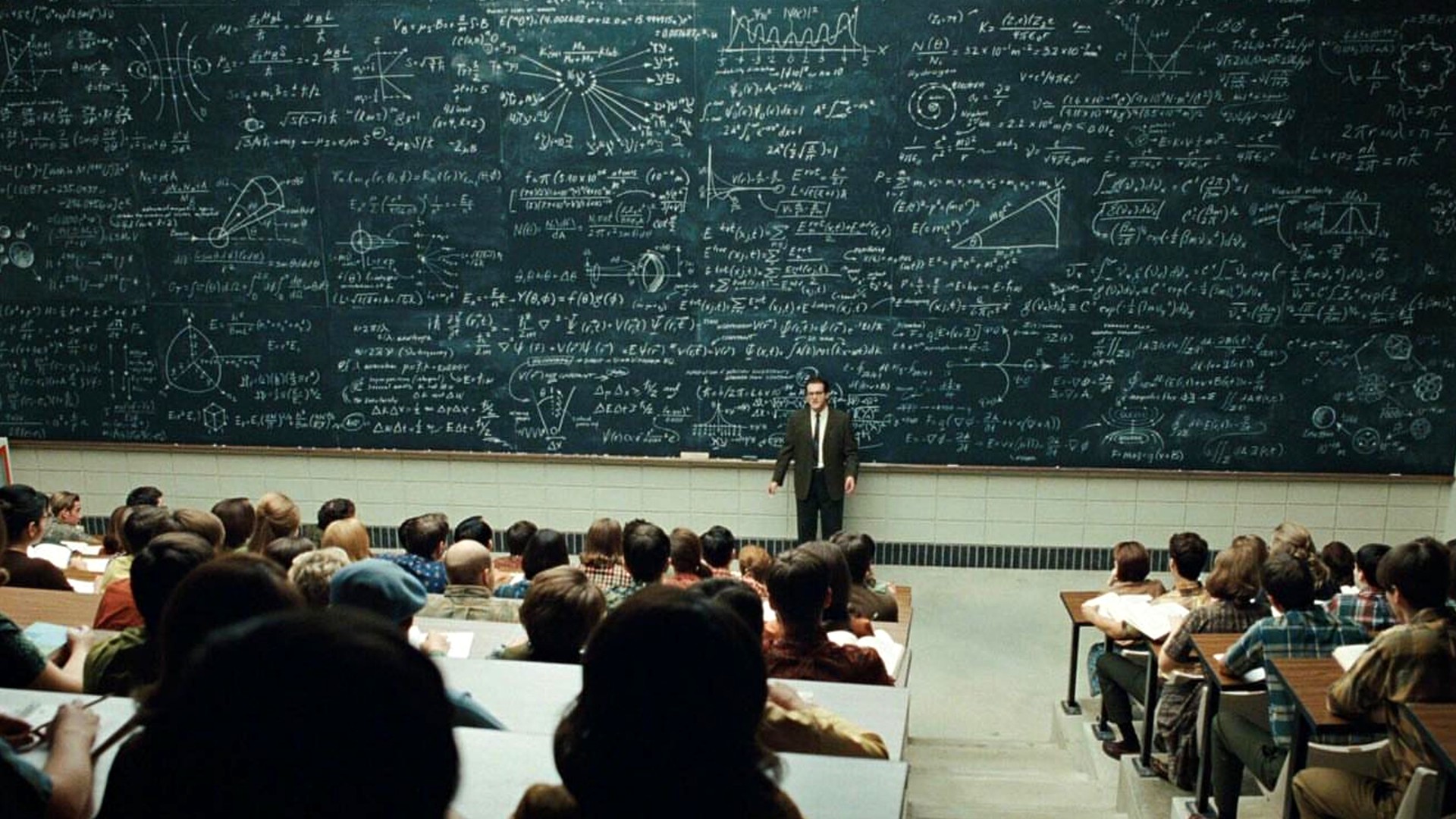
Each next lecture is a jungle of new formulas. They make studying quantum theory a madhouse.

American quantum computing scientist Scott Aaronson writes in his book “Quantum Computing Since Democritus”:
Look, if you teach an introductory course on quantum theory, and the students don't have nightmares for weeks, tear their hair out, wander around with bloodshot eyes, ets., then you probably didn't get the point accross.
But learning does not mean understanding. Quantum theory is too mad. Quantum physicists admit that few of them understand quantum theory.
Con #2. Programming
REI classic analysis is mostly programmed through spreadsheets, sometimes through popular programming languages like PHP or Python.
Quantum analysis is developed using programming languages for mathematical calculations. In such languages, it is possible to write mathematical formulas in a style familiar to mathematicians. They have by design:
- Rational numbers, imaginary numbers, matrices, sets, and other mathematical structures
- Multiply/summarize matrices, differentiate/integrate,... with a single line.
But most popular mathematical programming languages (MATLAB, GNU Octave, Scilab, R,...) are too slow. Quantum analysis requires mathematical programming languages that have the features to speed up quantum calculations:
- Compiling code
- Paralleling calculations on processor cores
- Distribution of calculations among many computers.
Con #3. Computer
Your smartphone smoothly displays FullHD video. It's 2 million pixels that refresh 30 times per second. Your smartphone easily shoots 1 million classic REI analyses every second.
Quantum analysis of a single property requires billions of times more computation than is needed for classical analysis. The duration of quantum calculations of a single real estate depends on the type of computer and takes:
- Years on a smartphone
- Months on a laptop
- Weeks on a desktop
- Days on a server with thousands of processor cores that cost over $10,000
- Hours on a supercomputer that cost over $1 million
- Minutes on a quantum computer that cost over $10 million:

FAQ
The prologue is coming to an end. It's a good time to answer frequent questions.
Q1: Is REI classical analysis dead now?
Classical and quantum analyses live peacefully, each is good in its own niche.
Classical analysis is useful in cases where its inaccuracies aren't important, but its speed and simplicity are in demand. These are training courses for novice investors, draft analyses, preparation of “pro forma” offers from wholesalers/syndicators,...
Quantum analysis of REI is in great demand when investing $100,000 or more. If an investor is looking to buy real estate or wants to reorganize their portfolio, he would probably prefer to make a decision based on REI Quantum Analysis.
Q2: Is Quantum Analysis a marketing name?
I agree, these days the word Quantum is attached to anything. Quantum cocktail:

But in science, the word Quantum denotes theories related by a general quantum concept:
- Quantum mechanics
- Quantum algebra
- Quantum logic
- Quantum biology
- Quantum social science
- etc.
The name “Quantum Analysis” reflects the fact that Quantum Analysis uses the conceptual apparatus and mathematical methods of quantum theory.
Q3: How do I add my question here?
Ask me your question in the contact form or send me a personal message in BiggerPockets.
Red Pill and Blue Pill
The video (2.5 minutes) is inspired by the movie Matrix:
